| Analysis of Digital Data Technologies Toward Future Data Eco-Society | Download report | 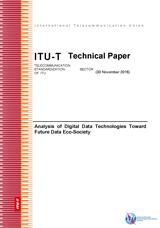 | This report focuses on key issues and requirements of future data technology. First, the existing digital data technology and standards are reviewed and analysed. Toward future data eco-society, the key features of existing data formats and standards are reviewed. | November 2016 |
| The Tactile Internet | Download report
|
 | This Technology Watch report outlines the potential of the Tactile Internet, exploring its promise in application fields ranging from industry automation and transport systems to healthcare, education and gaming. It goes on to describe the Tactical Internet’s demands on future digital infrastructure and its expected impact on society, concluding with a brief discussion of the role to be played by the ITU framework. | August 2014 |
| Big Data: Big today, normal tomorrow | Download report
|
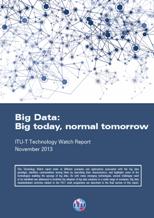 | This Technology Watch report looks at different examples and applications associated with the big data paradigm, identifies commonalities among them by describing their characteristics, and highlights some of the technologies enabling the upsurge of big data. As with many emerging technologies, several challenges need to be identified and addressed to facilitate the adoption of big data solutions in a wider range of scenarios. Big data standardization activities related to the ITU-T work programme are described in the final section of this report. | November 2013 |
| Location matters: Spatial standards for the Internet of Things | Download report
|
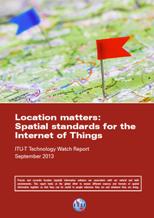 | Precise and accurate location (spatial) information enhance our association with our natural and built environments. This report looks at the global effort to weave different sources and formats of spatial information together so that they can be useful to people wherever they are and whatever they are doing. | September 2013 |
| The Mobile Money Revolution - Part 2: Financial Inclusion Enabler | Download report
|
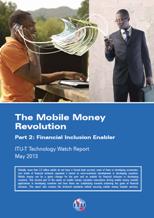 | Globally, more than 2.5 billion adults do not have a formal bank account, most of them in developing economies. Low levels of financial inclusion represent a barrier to socio-economic development in developing countries. Mobile money can be a game changer for the poor and an enabler for financial inclusion in developing countries. This second part of the report on mobile money considers innovations driving mobile money transfer applications in developing countries and how these are contributing towards achieving the goals of financial inclusion. This report also reviews the technical standards behind securing mobile money transfer services. | May 2013 |
| The Mobile Money Revolution - Part 1: NFC Mobile Payments | Download report
|
 | Mobile money refers to financial transactions and services that can be carried out using a mobile device such as a mobile phone or tablet. These services may or may not be linked directly to a bank account. Previously, recharging your mobile meant adding more airtime but now increasingly you will be able to add money to it, keep all your credit cards and loyalty coupons, access your bank account and use it like your ordinary wallet for payments. Innovations in mobile money could lead to a drastic change in the way people pay for goods and services in the near future. This report surveys and analyses the innovations in the mobile payments landscape and their likely impact on future standardization activities. | May 2013 |
| Smart Cities - Seoul: a case study | Download report
|
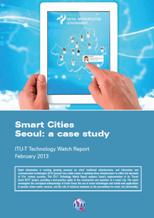 | Rapid urbanization is exerting growing pressure on cities’ traditional infrastructures, and information and communication technologies (ICTs) present very viable means of updating these infrastructures to reflect the demands of 21st century societies. This ITU-T Technology Watch Report analyses Seoul’s implementation of its "Smart Seoul 2015" project, providing a best-practice guide to the construction and operation of a smart city. The report investigates the conceptual underpinnings of Smart Seoul, the use of smart technologies and mobile-web applications to provide citizen-centric services, and the role of technical standards as the precondition for smart city functionality. | February 2013 |
| Standards for technology-enabled learning | Download report
|
 | Education is a pre-requisite to using information and communication technologies (ICTs) but these same technologies can be a tool to facilitate learning processes and education reaching beyond classrooms as we know them. This report surveys technology-enabled learning and emerging technologies, which, if applied in an educational context, can contribute to more efficient and more affordable education and training for all. For a number of years now, standardization bodies have been defining standards and guidelines for ICT-enhanced distance learning scenarios, and their output is taken up in this report with a view to exploring and identifying new applications and directions of this work. | September 2012 |
| E-health standards and interoperability | Download report
|
 | E-health systems can potentially transform healthcare through mobile health delivery, personalized medicine, and social media e-health applications. Reaching the potential for advancements in e-health will only be achieved through information and communication technology standards efforts that facilitate interoperability among systems and devices, provide unqualified privacy and security, address the unique needs of the developing world, and leverage existing ubiquitous technologies such as social media applications and mobile devices. | April 2012 |
|
Privacy in cloud computing | Download report
|
 | Privacy concerns are increasingly important in the online world. It is widely accepted that cloud computing has the potential to be privacy disabling. The secure processing of personal data in the cloud represents a huge challenge. Adoption of privacy-enhancing technologies to support such activities in the cloud will depend upon the existence of uniform ways of handling personal data at the international level and on technical standards which can help to demonstrate compliance with legal and regulatory frameworks. | March 2012 |
|
Digital signage: the right information in all the right places | Download report
|
 | This ITU-T Technology Watch Report highlights digital signage as an innovative medium for targeted information, entertainment, merchandising and advertising. Advancements in display technologies, falling manufacturing costs and a retail boom in emerging economies are contributing to the economic uptake and rapid spread of large-scale high-definition display networks. The report identifies trends to making digital signage more interactive and pervasive and describes why interoperability and global standards are key to tapping the medium’s full potential. | November 2011 |
|
Trends in video games and gaming | Download report
|
 | Video gaming is a global phenomenon, a fast-moving multibillion dollar business, cutting across all age groups and gender. This ITU-T Technology Watch Report surveys some of the latest developments in the world of video games, describes the most common gaming platforms and terminals and highlights new technologies enabling a better gaming experience and associated standardization activities. | September 2011 |
|
The optical world | Download report
|
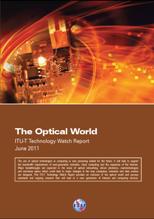 | The optical world, referring to the use of optics in computing, is very promising indeed for the future to support the bandwidth requirements of Next Generation Networks, Cloud Computing and expansion of the Internet. Major breakthroughs are expected in the area of silicon photonics, nanotechnologies and non-linear optics which could lead changes in the way computers and data centers are designed. This ITU-T Technology Watch Report provides an overview of the optical world and surveys standards and ongoing research work which will lead to a new generation of Internet and computing devices. | June 2011 |
| Standards and e-health | Download report
|
 | E-health systems that use information and communication technologies for the delivery of healthcare services and information hold great promise for improving global access to healthcare services and health information, particularly in the developing world. Delivering on this promise requires more universal e-health interoperability standards, overcoming technical infrastructure barriers, and addressing privacy, security, and other legal requirements. This report envisions the future of e-health, presents a snapshot of the current e-health standardization landscape, describes some obstacles that must be overcome, and identifies the emerging standardization opportunities and activities within the ITU that will contribute to the global deployment of efficient and secure e-health systems. | January 2011 |
|
Using submarine communications networks to monitor the climate | Download report
|
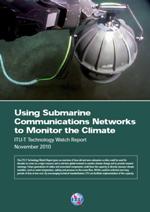 | This ITU-T Technology Watch Report gives an overview of how old and new submarine cables could be used for decades to come as a major resource and a real-time global network to monitor climate change and to provide tsunami warnings. Future generations of cables and associated components could have the capacity to directly measure climate variables, such as water temperature and salinity, as well as give pressure readings on the ocean floor. All this could be achieved over long periods of time at low cost. By encouraging technical standardization, ITU can facilitate implementation of this capacity. | November 2010 |
| ICT as an enabler for smart water management | Download report
|
 | Smart water management has become a key policy issue for the 21st century, as a growing number of factors are impacting the delivery of already scarce fresh water to millions of people. Economic growth, seasonal climatic conditions and rising population are all affecting availability of water resources. Moreover, a number of effects linked to climate change, such as lengthy droughts and extreme weather events, are worsening the situation. This ITU-T Technology Watch Report provides an overview of how ICT can be a strategic enabler for smart water management policies and surveys upcoming ICT standards that will enable smart water initiatives. | October 2010 |
|
Decreasing driver distraction | Download report
|
 | Texting, making calls, and other interaction with in-vehicle information and communication systems while driving is a serious source of driver distraction and increases the risk of traffic accidents. Technology-caused driver distraction is a global problem and has its stake in the more than 1.2 million people dying in road crashes each year. This ITU-T Technology Watch Report provides an overview of technology-caused driver distraction and surveys standards, guidelines and initiatives aiming at making the use of in-vehicle information and communication systems less distracting. | August 2010 |
Earlier Reports |
| Biometrics and standards | Download report | Biometric recognition can be described as automated methods to accurately recognize individuals based on distinguishing physiological and/or behavioral traits. The report spotlights biometric recognition as a key form of authentication, one which is increasingly used in a wide range of applications made possible by advanced pattern recognition algorithms applied through powerful ICT. | December 2009 |
| ICTs and food security | Download report | Food security and hunger are global concerns. This Technology Watch Report examines some of the main ways in which Information and Communication Technologies (ICTs) can be used locally and globally to address the problems of food security and hunger and reviews the relevant ICT standardization work. | July 2009 |
The future Internet
|
Download report | The Internet has grown from a small experiment into a collaborative network with more than one billion users. The rise of mobile access poses additional infrastructure challenges including addressing and routing, which might require a review of the architecture. This Report surveys the current debate over the Internet architecture, and identifies key emerging trends and features of the Internet, in an attempt to provide pointers for future standards work for consideration by the ITU-T membership and the broader standards community. | April 2009 |
| Distributed computing: utilities, grids & clouds | Download report | Terms such as ‘Cloud Computing’ have gained a lot of attention, as they are used to describe emerging paradigms for the management of information and computing resources. This report describes the advent of new forms of distributed computing, notably grid and cloud computing, the applications that they enable, and their potential impact on future standardization. | March 2009 |
| Standardization activities for intelligent transport systems |
Download report
| Intelligent Transport Systems (ITS) are used to improve traffic flow, to increase the efficiency of freight and public transportation, and to reduce fuel consumption. ITS could also become a tool to improve road safety, for instance through emergency vehicle notification systems, collision avoidance systems, and also through automatic road enforcement. The report identifies the main functionalities of ITS, analyzes ITS-related standardization activities, and identifies possible future work on ITS in ITU-T. | October 2008 |
| NGNs and energy efficiency | Download report
| The term “Next Generation Network” (NGN) is commonly used to describe the changes currently underway in the telecommunications sector as it migrates from today’s separate networks (for voice, mobile, data etc) to a single, unified IP-based NGN. The global migration to NGNs should bring about a substantial reduction in power consumption and thereby reduce the telecommunication sector’s contribution to global warming. NGN should lead to improved efficiency in the energy requirements of data centres, transmission and end-user equipment and its high operation efficiency as well as providing the underlying platform to implement carbon reductions in other sectors of the economy. NGNs are expected by some commentators to reduce energy consumption by 40 per cent compared to today’s PSTN. | August 2008 |
| Technical aspects of lawful intercept |
Download report | Popularly called wiretapping – describes the lawfully authorized interception and monitoring of telecommunications. With the existing Public Switched Telephone Network (PSTN), LI is performed by applying a physical ‘tap’ on the targeted telephone line, usually by accessing digital switches of service providers. However, the future of the telephone seems to be intertwined with the Internet and mobile networks, which introduce new challenges for LI systems. Law enforcement agencies oblige telecommunication operators to comply with new laws. Requirements differ from one country to another – standardization could assure transparent and secure interception interfaces. | May 2008 |
| Remote collaboration tools | Download report | "Increase productivity, save time and money while reducing your company’s carbon footprint"; this is the ambitious sales pitch for a new family of tools that promise to offer the 3Cs—communication, collaboration and coordination—without the requirement for physical travel. This report describes how Remote Collaboration Tools can facilitate collaboration with colleagues, and support businesses in overcoming the geographical limitations of everyday work. For developing countries, in particular, remote collaboration tools can be an important step towards bridging the standardization development gap and the wider digital divide. | March 2008 |
| Ubiquitous sensor networks | Download report | The term “Ubiquitous Sensor Networks” (USN) is used to describe networks of intelligent sensor nodes that could be deployed “anywhere, anytime, by anyone and anything”. The technology has huge potential as it could generate applications in a wide range of civilian and military fields, including ensuring safety and security, environment and habitat monitoring, real-time healthcare, landmine detection and intelligent transport systems (ITS). | February 2008 |
|
ICTs and climate change | Download report | This report looks at the potential role that information and communication technologies (ICTs) play at different stages of the process of climate change, from contributing to global warming, to monitoring it, to mitigating its impact on the most vulnerable parts of the globe, to developing long-term solutions, both directly in the ICT sector and in other sectors like energy, transport, buildings etc. The final sections look at what ITU-T is already doing in this field and strategic options for the future. | December 2007 |
| Telepresence: high-performance video conferencing | Download report | TelePresence is the next step in high-performance, studio-based video-conferencing, which promises to give users the experience of “going there without being there”. This report looks at the technology behind TelePresence and its potential applications in business as well as in fields like medicine, education and outsourcing. ITU-T standards, such as H.323 are at the heart of video-conferencing technology, and the report also looks at new developments, such as Advanced Multimedia Systems (AMS). | November 2007 |
Intelligent transport systems and CALM
| Download report | Intelligent Transport Systems make it possible to imagine a future in which cars will be able to foresee and avoid collisions, navigate the quickest route to their destination, making use of up-to-the-minute traffic reports, identify the nearest available parking slot and minimize their carbon emissions. A new set of standards—Continuous Air-interface for Long- and Medium-range communications (CALM)—promise to provide the underlying glue to make all this happen, and are the subject of this report. | October 2007 |
TechWatch Alerts (Short Reports) |
|
Batteries for portable ICT devices | Download report | Batteries are a major technological challenge for increasingly complex mobile and portable applications and ICT devices. This article summarizes key trends and developments in battery technologies for mobile devices. | February 2010 |
| Mobile Apps | Download report | Mobile applications (apps) are add-on software for handheld devices, such as smartphones and personal digital assistants (PDA). This article describes the mobile application market and identifies initiatives that aim at an open and interoperable mobile environment. | July 2009 |